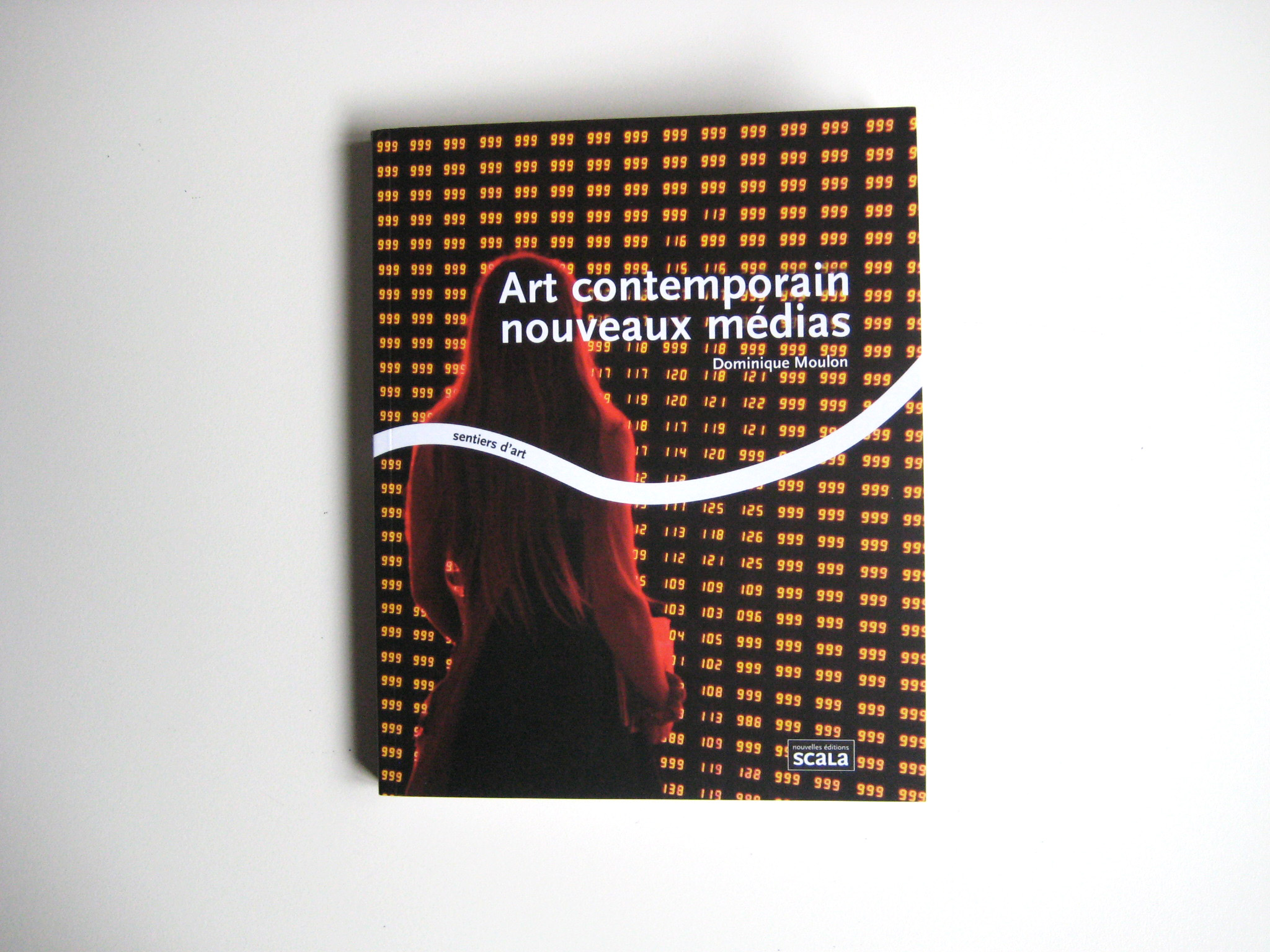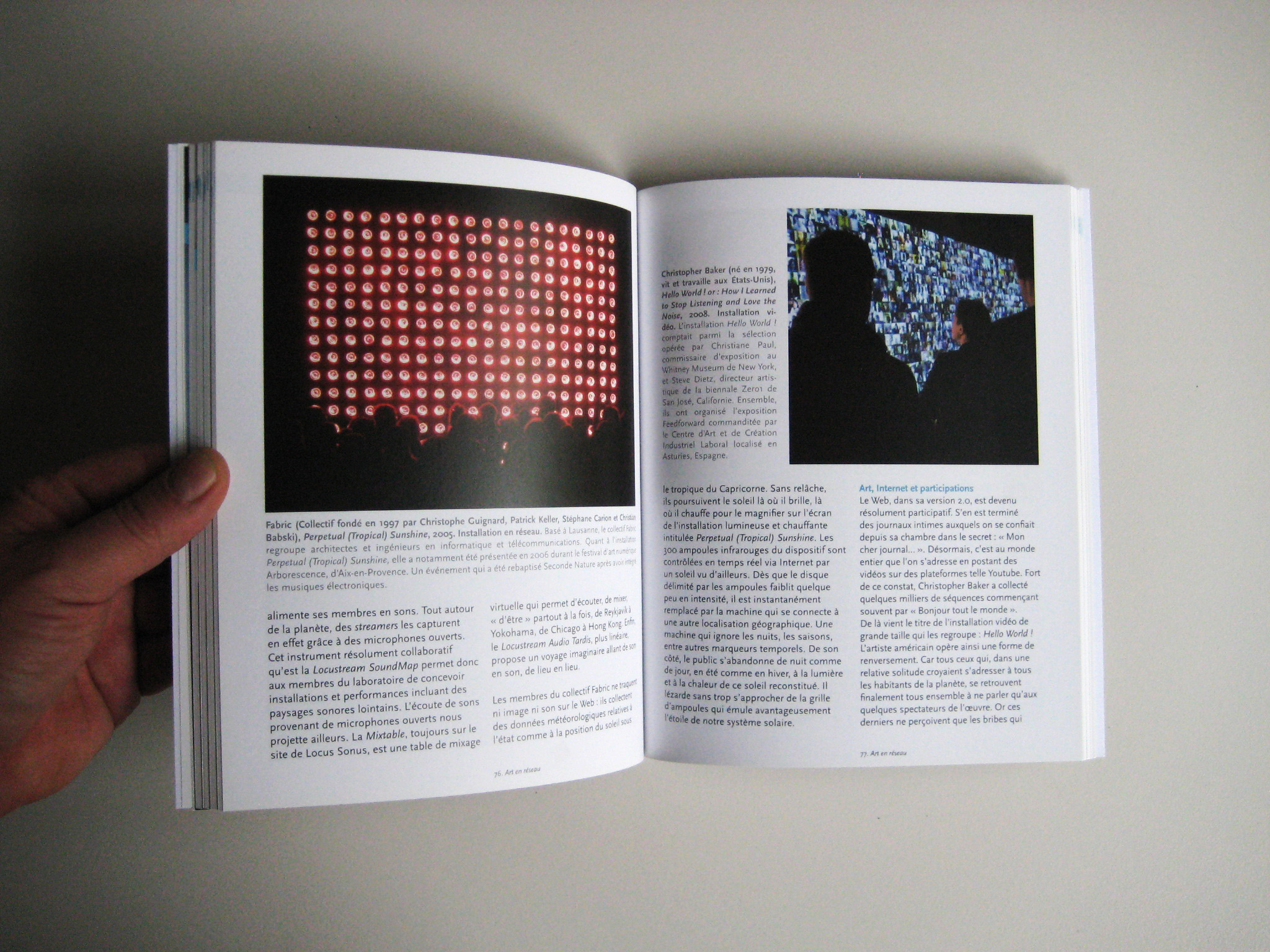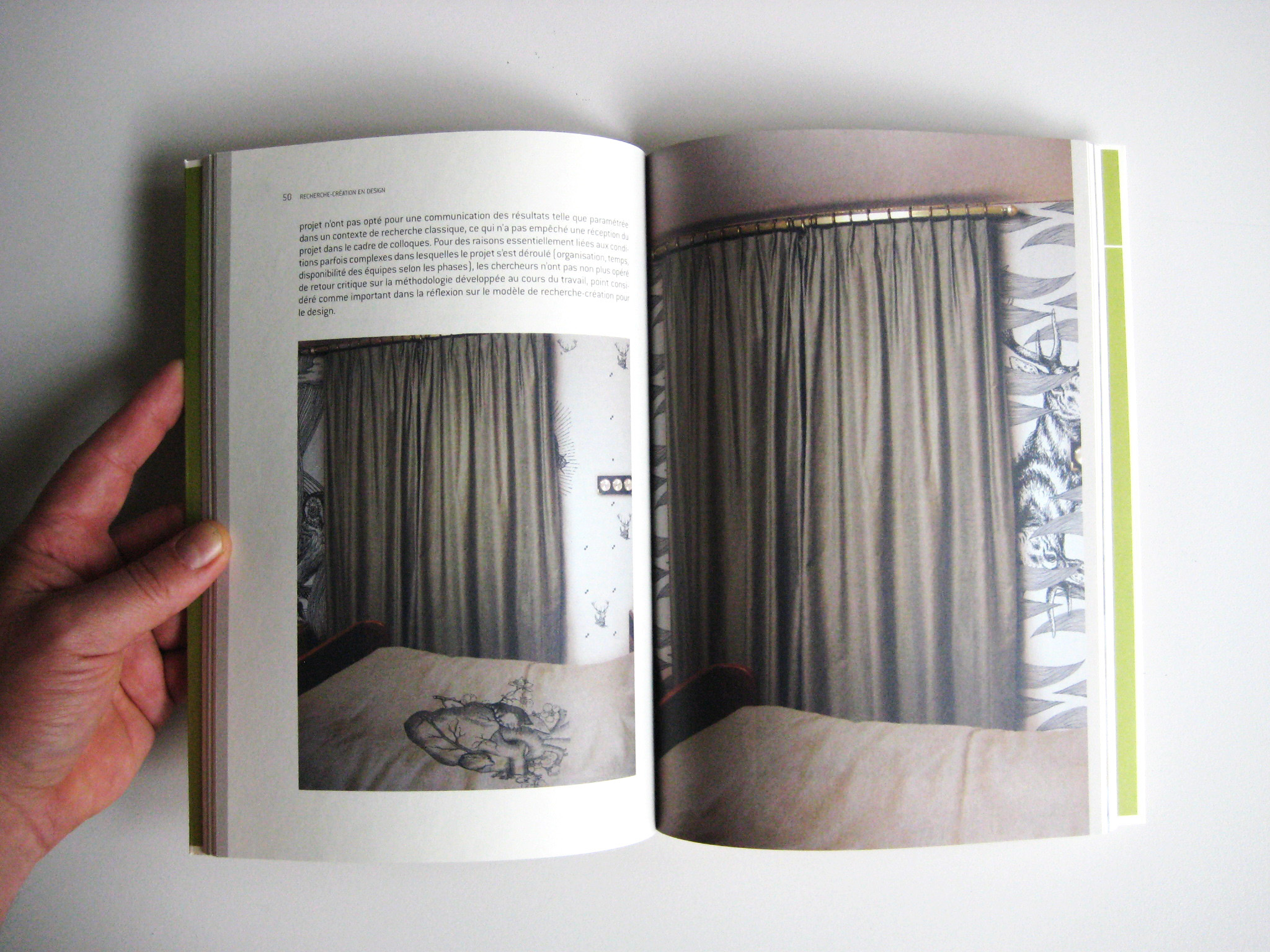Friday, November 05. 2010
Via Pruned
-----
by Alexander Trevi
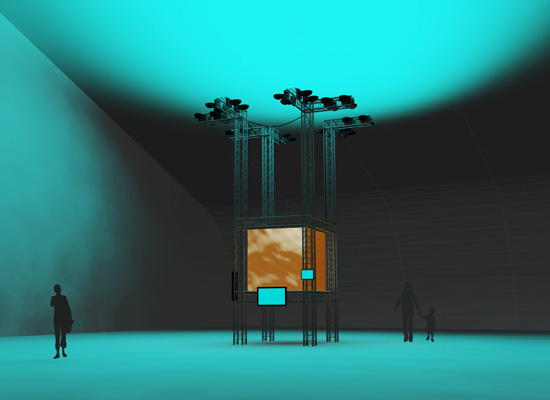
( Deep Space Public Lighting by fabric | ch. Image courtesy of the artists.)
For the past few months, I-Weather.org, developed by Philippe Rahm and fabric | ch, has been churning up a pastel maelstrom here on this blog for use by our spatially and temporally displaced readers to restore their circadian rhythms, whether this is actually possible or not. You, too, can embed this artificial sun on your website to blast your asynchronous readers into metabolic normality. Its open source code is freely available.
At the recent 01SJ Biennial in San Jose, California, we saw a less earthbound and less private platform for this quasi-light therapy: a flickering light tower for “confined and conditioned environments of space exploration vehicles” and “speculative public spaces of distant colonies.”
To distribute and synchronize these pockets of simulant terrestrial cycles of day and night across vast distances, fabrica | ch proposes using a theoretical Deep Space Internet.
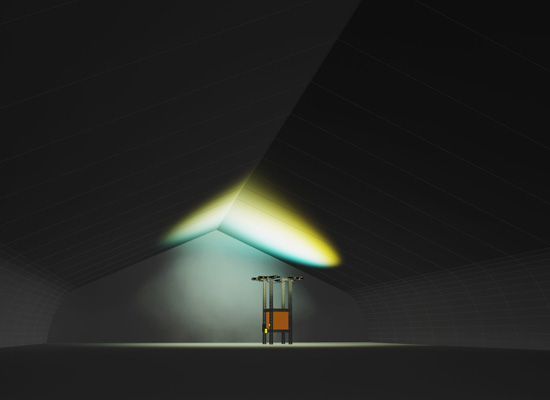
( Deep Space Public Lighting by fabric | ch. Image courtesy of the artists.)
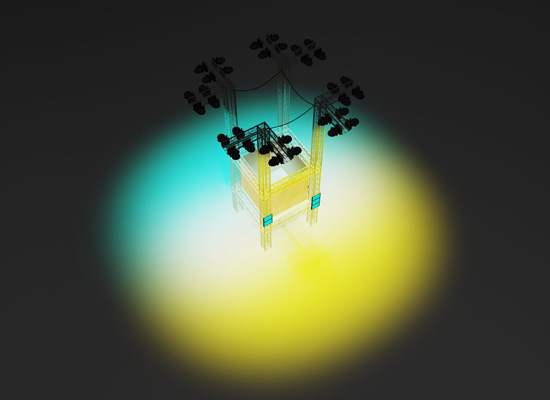
( Deep Space Public Lighting by fabric | ch. Image courtesy of the artists.)
By happy coincide, we first learned about this project just as the first reports about the trapped miners in Chile started trickling in to our attention, specifically, the news that NASA scientists have been flown in by the Chilean government to offer advice on how to help the men stay physically and mentally healthy during the weeks-long rescue.
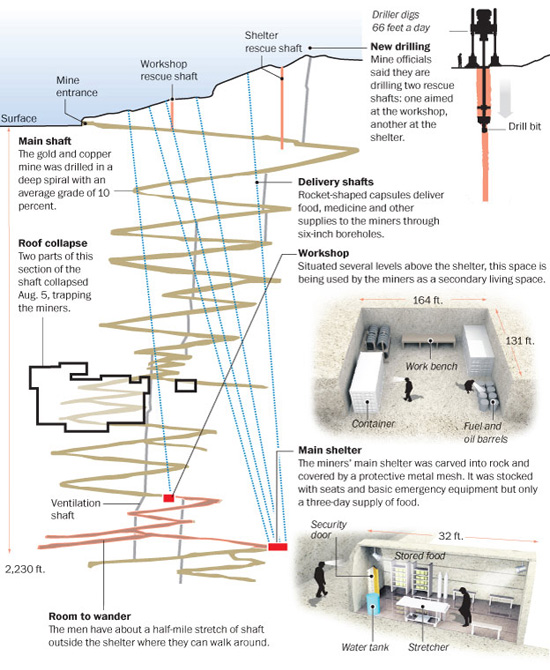
(Graphics and research by C. Argandoña, I. Muñoz, C. Araya, J.Cortés/LA TERCERA, via The Washington Post. Source)
Al Holland, a NASA psychologist, says during a press conference:
One of the things that's being recommended is that there be one place, a community area, which is always lighted. And then you have a second area which is always dark for sleep, and then you have a third area which is work, doing the mining, and the shifts can migrate through these geographic locations within the mine and, in that way, regulate the daylight cycle of the shift.
It occurred to us that one should make a portable version of Deep Space Public Lighting for future mining disasters. It should be able to fit through bore holes and then easily assembled by survivors in the murky depths of a collapsed tunnel.
A deployable piazza for subterranean “distant colonies.“
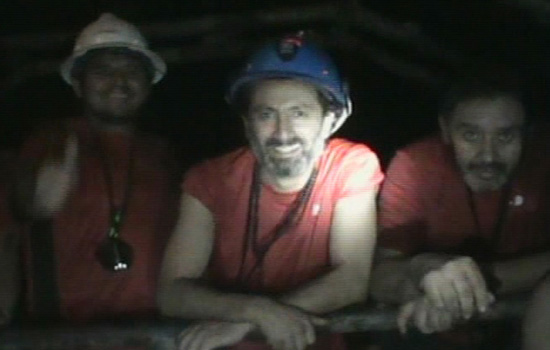
(Trapped miners at the Copiapó mine on video. Image via Reuters/Chilean Government. Source.)
Rather than being illuminated by the anemic brightness of a hard hat or video camera, one bathes in soothing electromagnetic wavelengths from a technicolor torch.
Or from an i-weatherized iPhone.
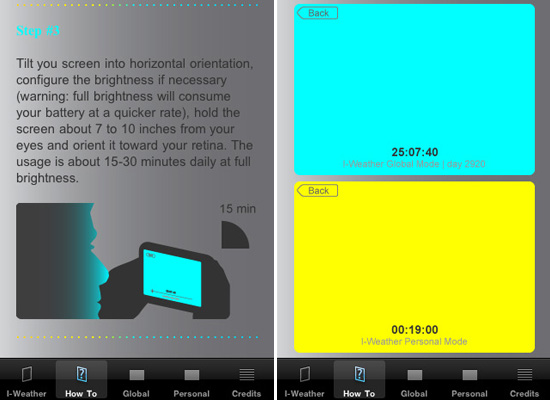
(There's an app for that.)
And yes, considering the high demand for coal and industrial minerals, there will be many more mining disasters, many more trapped miners and, depending on various fortunate circumstances, more tunnels to be reconfigured. In fact, only a few days after the last Chilean miner was brought to the surface, 11 miners were trapped at a coal mine in China after a deadly explosion.
Consider, too, the recent export ban by China on shipment of rare earth elements to Japan after a kerfuffle between the two countries involving a collision between a Chinese fishing trawler and Japanese Coast Guard patrol boats near some disputed islands. The ban may have been brief, and China may have denied having instituted one in the first place, nevertheless, the incident points again that China is willing to use its near resource monopoly of rare earth metals as a political tool, to get its way, in other words. Other countries have again taken notice, and are scrambling to develop alternative sources, if not already, to ensure future supply. With new mines opening and even old mine operations being restarted, there are more potentials for disasters.
Reformatted in this context, Deep (Inner) Space Public Lighting engages not just with issues such as “public space, public data, public technology and artificial climate” but also with the geopolitics of natural resources, globalization and our collective networked boredom that seemingly can only be satiated by an epic spectacle natural and man-made disasters and the ensuing heroic rescue of survivors.
Friday, October 01. 2010
Via fabric | ch
-----
(Sur un texte d'Emmanuel Mahe).
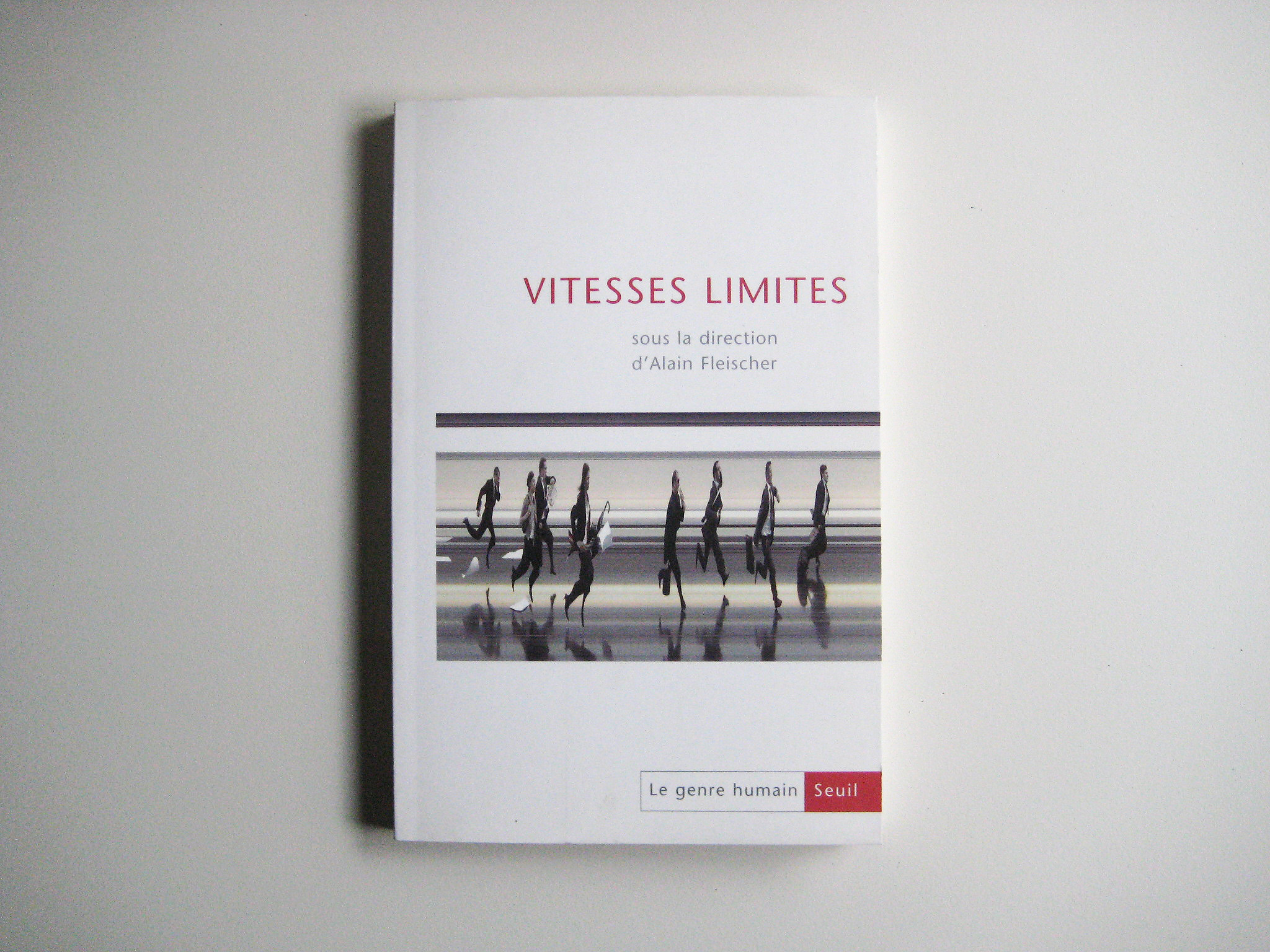
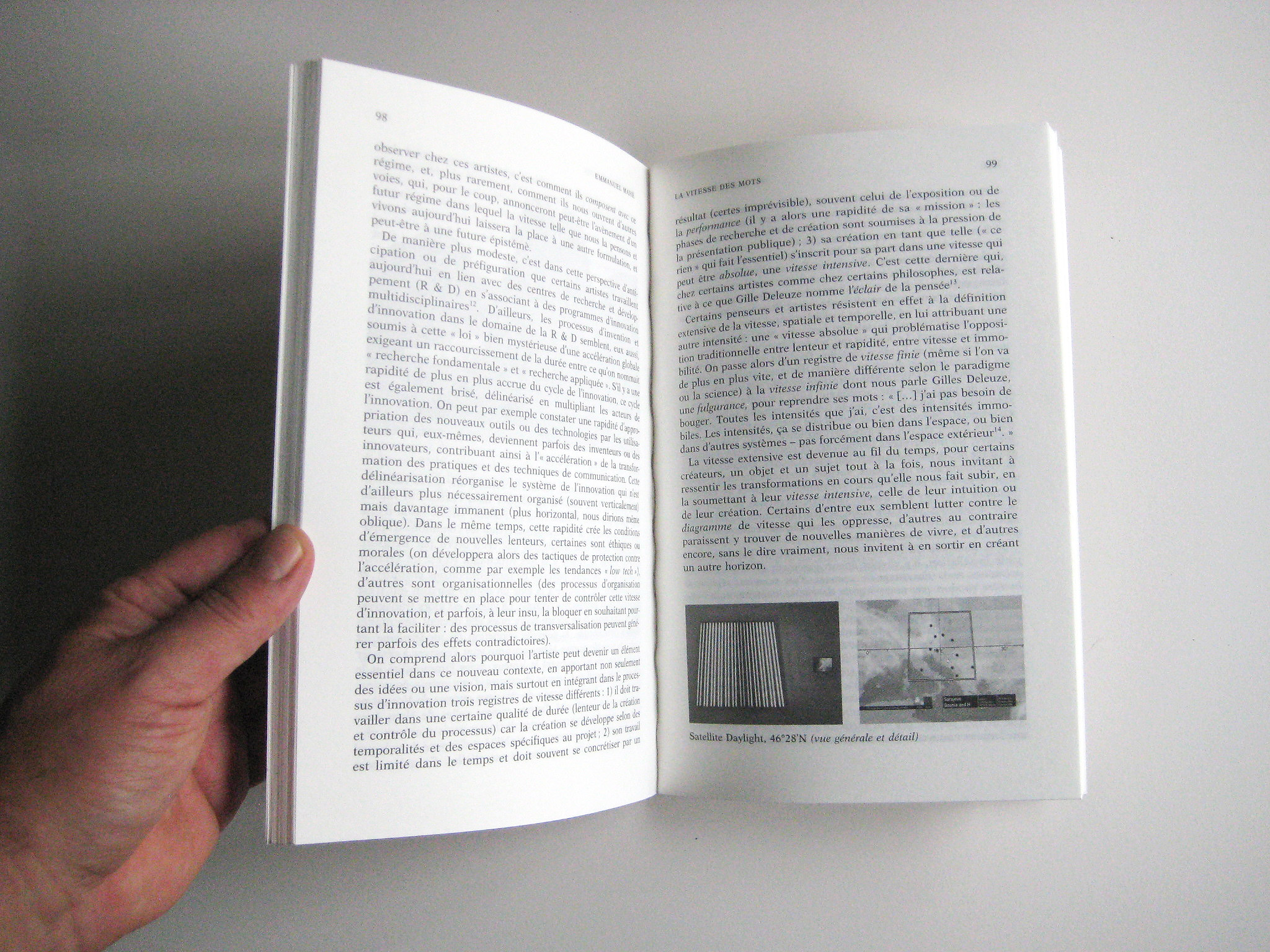
Friday, September 17. 2010
Via Edible Geography
-----
By Nicola
If you are in or near San Jose, California, this weekend, these are just some of the delights that await at this year’s 01SJ Biennial.
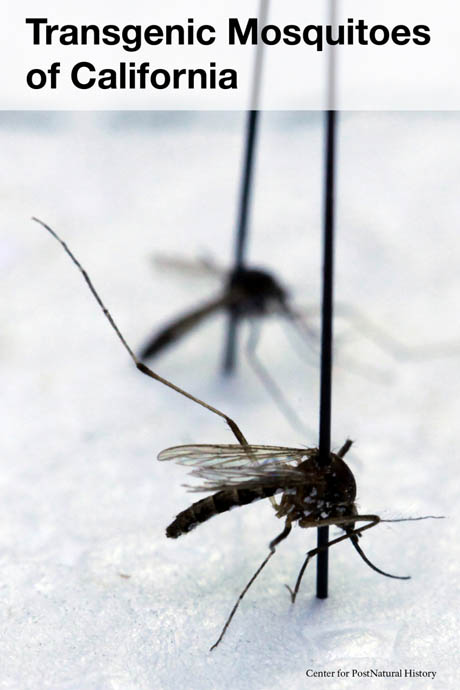
IMAGE: Transgenic Mosquitoes of California by the Center for PostNatural History.
Under the pioneering and Utopian instruction to “Build Your Own World,” the Biennial’s curators have assembled an enormous quantity of projects that, at a variety of scales, attempt to redesign our environment, infrastructure, atmosphere, and culture.
Unfortunately, some events have already come and gone — I would have loved to have been able to attend Tuesday’s Still Life with Banquet, in which media artist Grahame Weinbren partnered with chef Kitty Greenwald to serve a meal presented in Dutch still-life format, surrounded by video footage of the food’s decay.
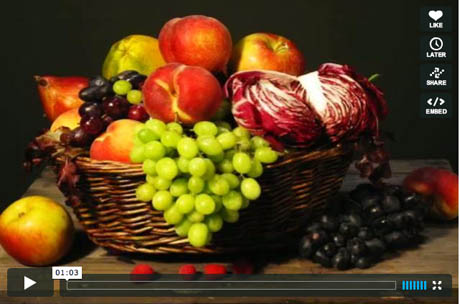
IMAGE: Click for video. Still from A1 (Linard), by Grahame Weinbren. Timelapse presentation of a twelve-week shot, based on a still life by seventeenth-century French painter, Jacques Linard.
It’s a clever conceit, but also — I imagine — functioned as a visceral reminder that our obsession with only buying flawless fruit and vegetables over-prioritises a single, freeze-framed moment in an organic cycle.
Ongoing displays include a Seed Garden Library, arranged by micro-climate suitability, from artist Amy Franceschini’s lovely Victory Gardens project, as well as a transgenic mosquito from the collections of the fascinating Center for Post Natural History. The insect, which has been developed in a biosecurity level 3 laboratory at the University of Bamako, in Mali, is designed to resist the malaria parasite, and should be ready for industrial production as early as next year.
According to a report on SciDev.Net, “The researchers hope that resistant mosquitoes will one day take over wild populations, eventually wiping malaria out.”
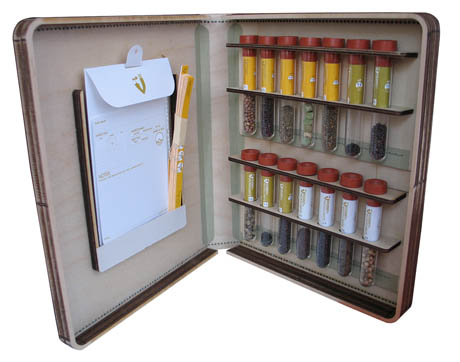
IMAGE: Amy Franceschini, Victory Garden Seed Library. (Photo by Amy Franceschini).
The San Francisco-based Studio for Urban Projects (SPUR) have created Public Orchard, an installation that includes heritage fruit trees as well as a discussion space to explore creative solutions to overcome city government resistance to urban edible landscapes. SPUR notes that “fruit trees are discouraged in the permit process because of concerns about the mess on city streets,” while fruit picking in parks is often “technically illegal, as it encourages ‘the destruction of park property.’”
In response, their installation investigates low-maintenance models of urban edible landscapes, municipal codes that encourage public foraging, and collaborative opportunities to harvest and preserve food.
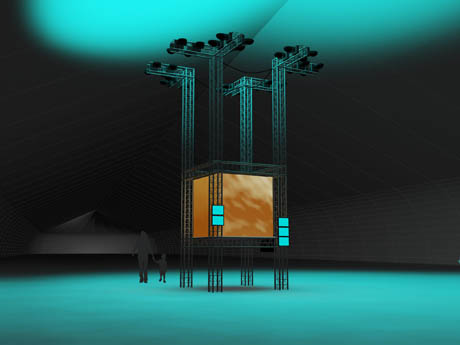
IMAGE: i-Weather, by fabric | ch, an installation at the Biennial that creates “an open-source artificial climate” — a parallel 25-hour day based on the most up-to-date knowledge of human metabolism, circadian rhythms, and the medical efficacy of light therapy.
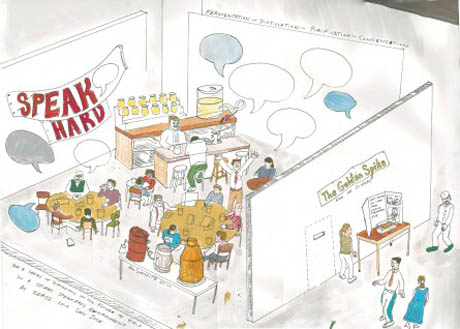
IMAGE: Sunshine Still, an Biennial installation by futurefarmers that uses a converted moonshine still to convert organic waste and algae into “engine-ready ethanol fuel by day and drinkable ethyl alcohol by night.”
Rebar, the creative genius behind today’s PARKing Day, are also represented at the Biennial, with their FarmCycle, “a pedal-powered alternative to the fossil-fuel driven tractor,” better suited to the needs of urban farmers. On a similar note, my generous hosts from earlier this week, Georgia Tech, have collaborated with The Public Design Workshop to create the Growbot Garden, which investigates a scaled-down form of precision agriculture, incorporating robotics and sensing technology into community gardens and green roofs.
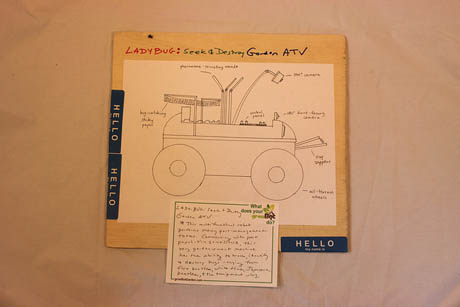
IMAGE: Ladybug board, part of the Growbot Garden Flickr set uploaded by Public Design Workshop.
Today’s events include a pop-up edition of the forageSF Underground Market, set up to skirt around legislation that keeps foraged produce out of farmers’ markets by restricting booths to “primary producers,” and not “gatherers,” as well as a not-to-be missed talk by Darrin Nordahl, author of Public Produce, on “municipal agriculture,” or practical strategies to encourage food production on public land (5:30 p.m., registration required).
Meanwhile, tomorrow’s highlights include a biodiesel bus tour of San Jose’s historic urban orchards, as well as an Imaginary Airforce Flight Attendant Training at designer Natalie Jeremijenko’s xAirport facility — your chance to glide along a zipline above the biodiverse riches of a constructed wetland (as opposed to squeezing into a fossil-fuel guzzling 747 on the environmental wasteland that is a runway built on “reclaimed” marsh).
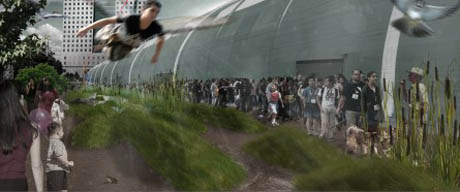
IMAGE: xAirport, courtesy David Fletcher.
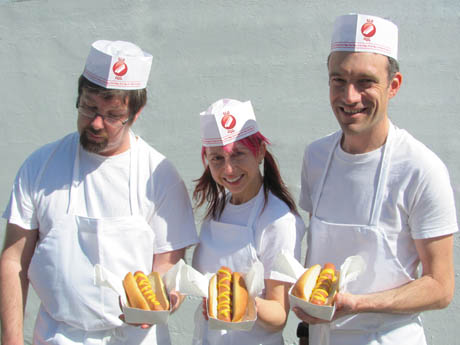
IMAGE: SLO DOG, a hot dog roller grill-inspired entry into Saturday’s Green Prix.
The Biennial closes on Sunday, September 19, accompanied by a Tomato Quintet (a “full set of tomato ripening data in a musification which is accelerated by a factor of 240X”) and accompanying fresh salsa. I wish I could be there — let me know what you think, if you go.
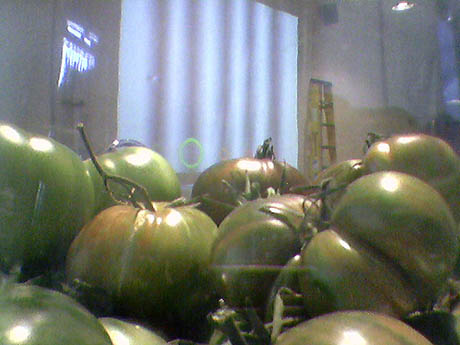
IMAGE: Tomato Quintet, in the recording studio. Photo by Greg Niemeyer.
Saturday, August 21. 2010
Via Domus, via Beatrice Galilee
-----
By Christophe Guignard
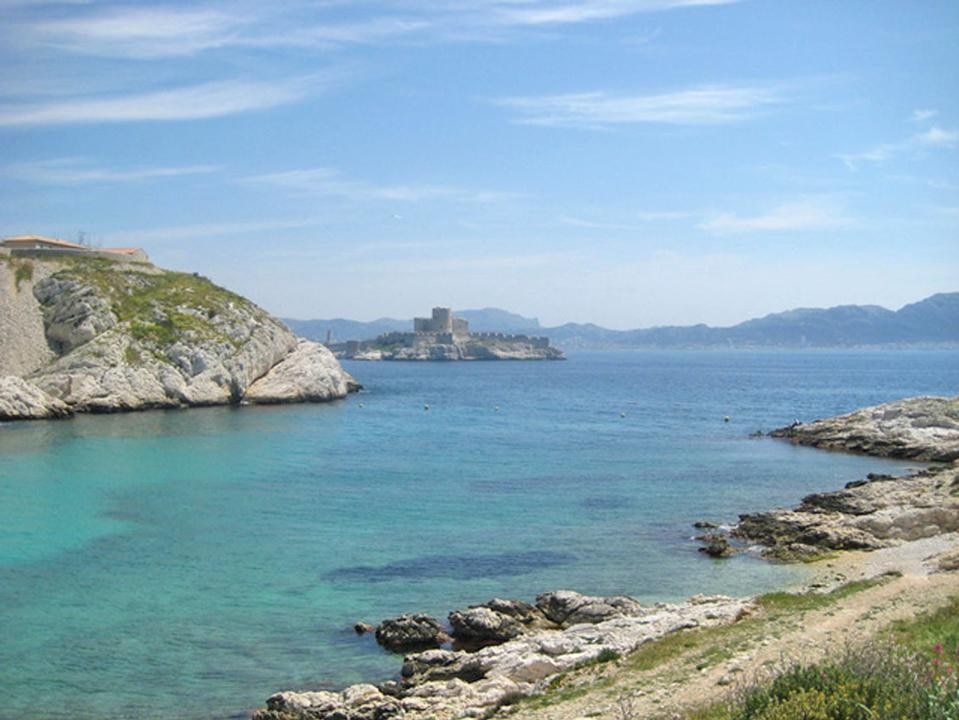
Arctic opening is an new installation for the Festival MIMI which is part of an outdoor exhibition presenting several works of art / experimental architecture. The aim of Arctic Opening is to let appear a "second day" made of a large artificial lighting, between Marseille's sunsets and sunrises, when the islands becomes dark and quiet. The light emitted by the installation will reproduce the luminous variations of a distant environment, where the sun shines 24 hours long during summer: the Arctic. This light, transported from North, will shine on a Mediterranean landscape, facing the Frioul port. Set up in a rocky zone swept by wind, close to an industrial ruin, Arctic Opening could also evoke a strange scientific expedition. Its sensing devices and climatic interfaces would analyze by anticipation a fictional and catastrophic future of an Arctic Ocean free of ice. BG
"Each day, when night falls on our urbanized landscapes in our cities, our streets or our ports, another day dawns, electric. It is literally a "second day" which begins: one of neon signs, street lights, sodium, mercury or fluorescent lighting, one of illuminated apartments and shops windows, one of night activities that we did not know two centuries ago.
Although today we no longer think much about it, this "second day" is now part of everyday life for city dwellers. Artificial light has been a conquest: by fire first, then by the gas, and more recently by electricity. This "fabricated" light permitted first to extend artificially the day at night to illuminate the darkness, but also to transform our relationship to time, to landscape and to space. It especially allowed to exceed the given natural immemorial cycle of day and night induced by the rotation of the Earth itself, and thus to redefine architectural and urban spaces.
One also began to design new architectures that did not require natural lighting anymore. In a few decades, artificial lighting profoundly altered the lifestyle of city dwellers, but not only: birds began to sing at night near the lampposts, insects to swarm under the spotlights and stars to disappear of the urban night sky, opening the door to a strange world, that combines natural and artificial cycles. Losses and gains then.
This environment, sometimes magical, sometimes disturbing, develops undoubtedly for us a poetry of shifts. Now, the challenge is to deploy these shifts, which combine presents and futures, into a comprehensive reflection on our contemporary space and our consumption of energy.
Designed for the Innovative Music Festival (MIMI 2010) in Marseille, on the Frioul islands, Arctic Opening does not aim to deny this "second day", but to amplify its positive and sensitive issues. Thus, Arctic Opening seeks to develop the potential of imagination(s) of artificial illumination, while integrating new technologies and intelligent lighting cycles of low energy consumption.
In a global environment, endlessly interconnected, which develops new forms of mobility, temporalities, and social behaviours at the crossings of time zones, this artificial day provides an opportunity for another kind of "days", simultaneous and distant: an imaginary or mediated "connection" with countries where precisely and literally, at the same time, the sun is shining. Through satellite imagery and sensor data, it is now possible to imagine opening a "window" onto a sensitive and remote light whose intensity varies continuously, the sky is sunny, then cloudy, then possibly sunny again. A window "teleporting" abstractly a remote atmosphere without physical mobility, without means of transport other than transportation data from there to here.
With Arctic Opening, fabric | ch proposes to create such an "opening" at a large scale, to another day: an artificial and sensitive light, revealing some geographical patterns, luminous and meteorological, across the globe (to the summer of one hemisphere corresponds the winter of the other, to the daylight the darkness, to the perpetual light of a pole the night of the other, etc.). When night falls over Marseille this "second day" gets up with its source somewhere north of the Arctic Circle, on the edge of the habitable zones, where once the ice melted new navigation routes open and will open more and more in the future.
Fed by light coming from regions, where in this season, the horizontal light of the sun never sets, where sunrise and sunset mix, Arctic Opening reproduces the continuous modulation of the northern summer. Composed of hundreds of light emitting diodes (LEDs), this bright band long of eighteen meters illuminates a rocky landscape, swept by winds. At sunrise, it goes slowly to reveal a temporary installation of pipes, placed there to conduct this experiment in distant light. Erected near the vicinity of a military and industrial relic of the twentieth century, a tent hosting the instruments of control suggests a possible scientific expedition in an "hostile" zone.
The combination of light produced by this window and the Frioul islands' landscape produces a composite territory: Arctic Mediterranea, remote nocturnal day. This hybrid area in mixed light is purposely created as a prospective environment, which evokes the contemporary patterns of mobility and crossing time zones, the fluxes and the networks, the artificiality and the mediatization, or to indicate the strange topographic similarities between the arid Frioul islands and the Arctic regions where no tree grows.
As if this temporary place in front of Marseille, illuminated by a light transported from the Arctic could become the distant, catastrophic and fictitious future of these northern territories: warmed by climatic changes, visited by boats navigating on new routes opened by melting ice, the shores of the Far North could begin to resemble those of the Mediterranean Sea. This environment would then hybridize himself as well, as people become increasingly mobile over time: mix of here and elsewhere, future and present, material and immaterial.
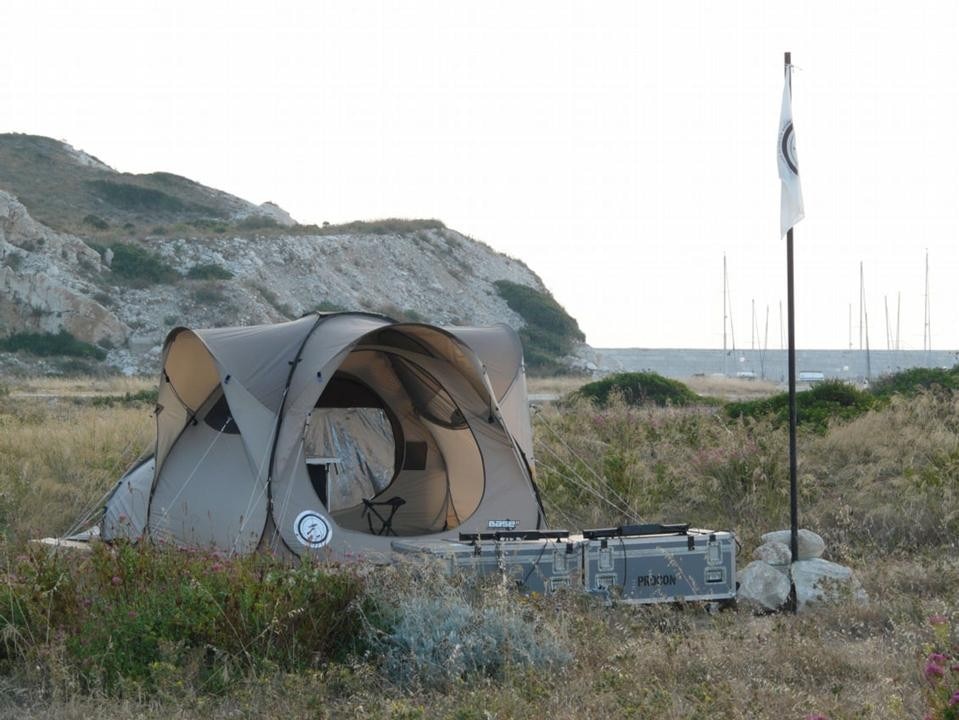
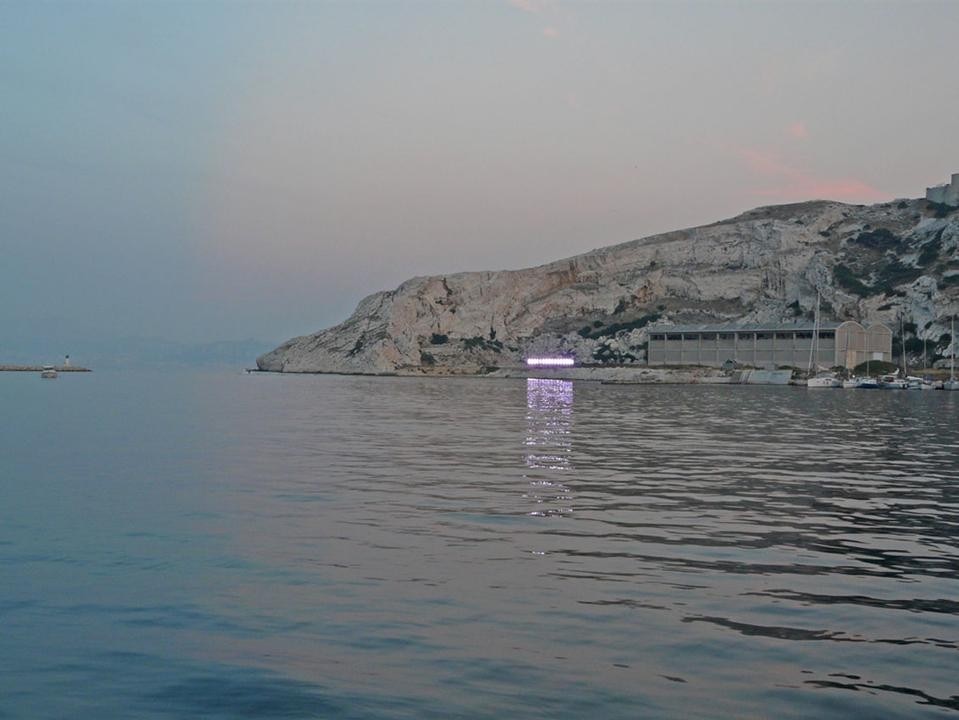
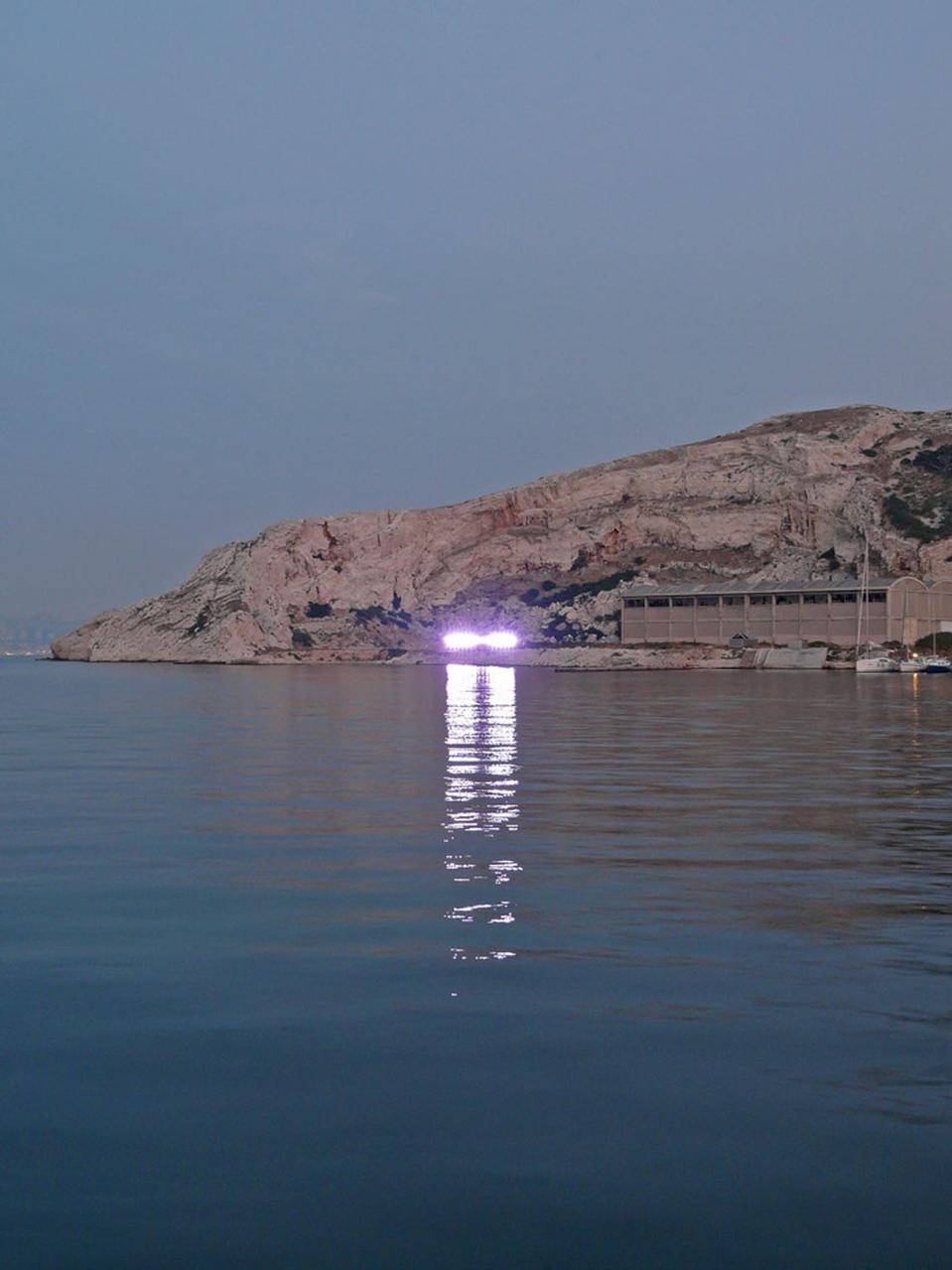
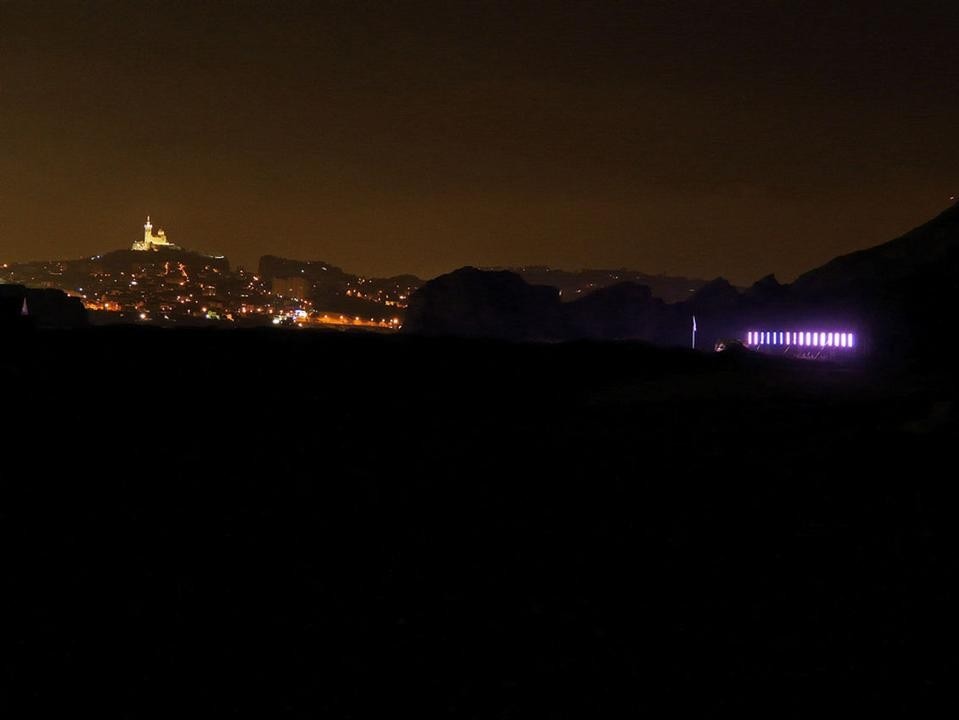
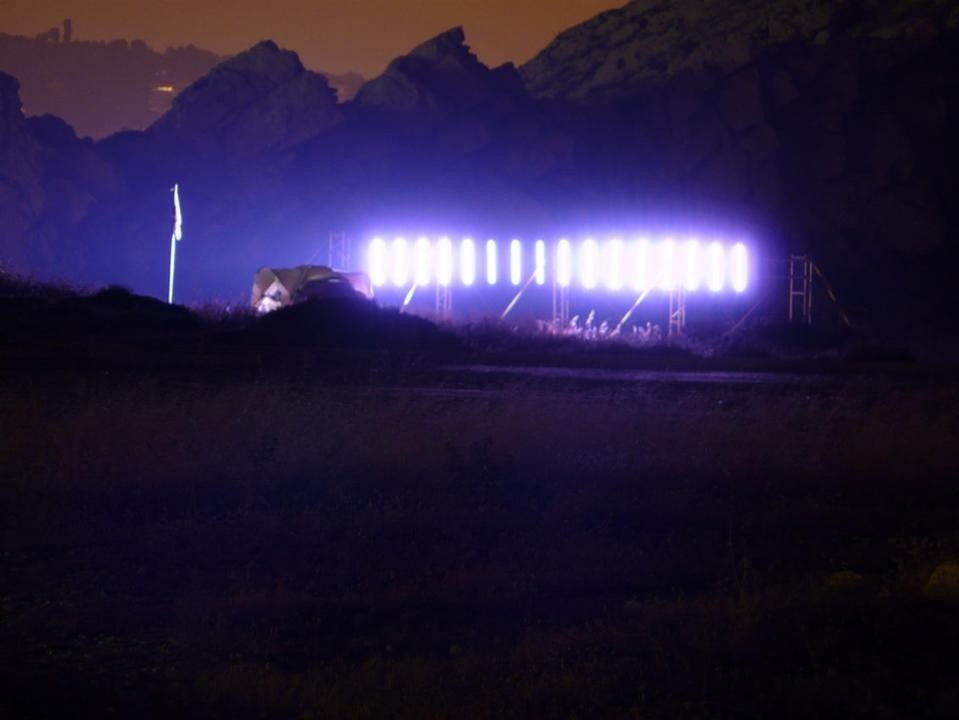
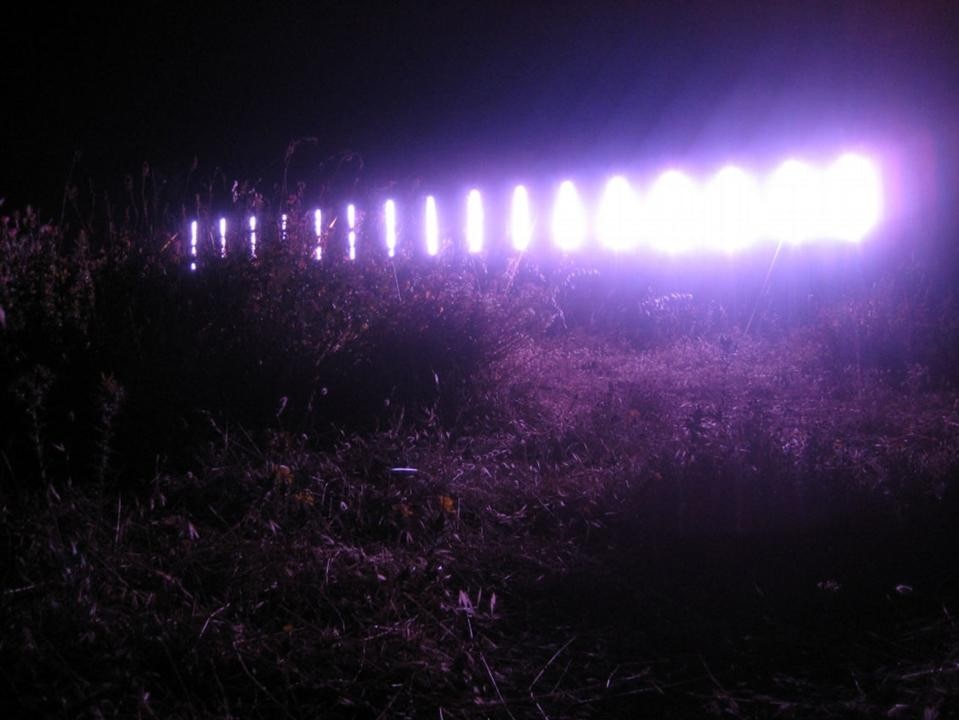
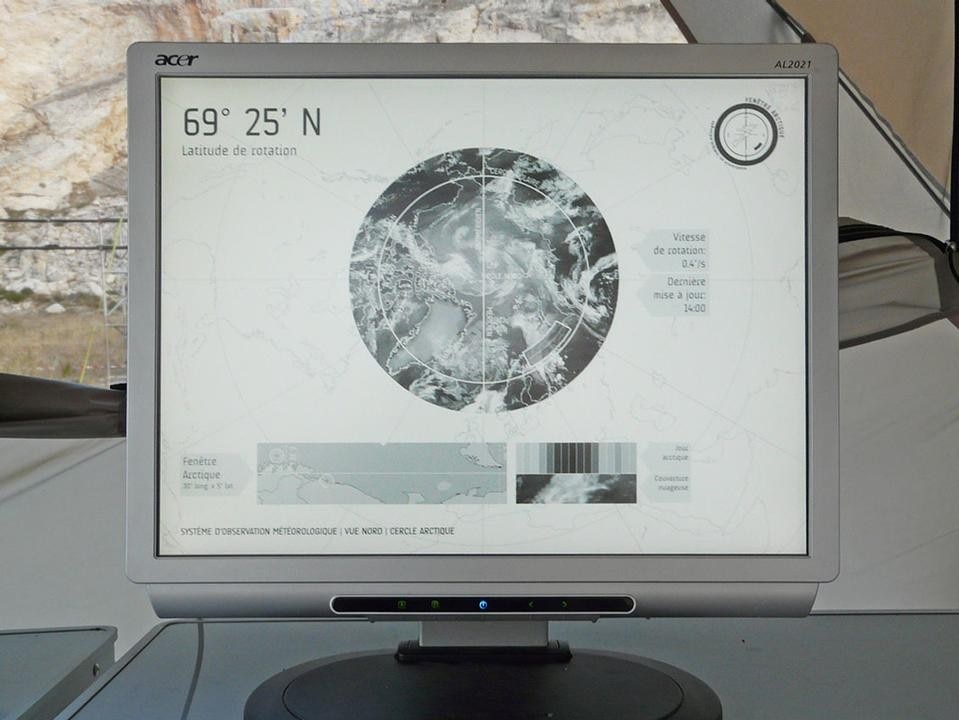
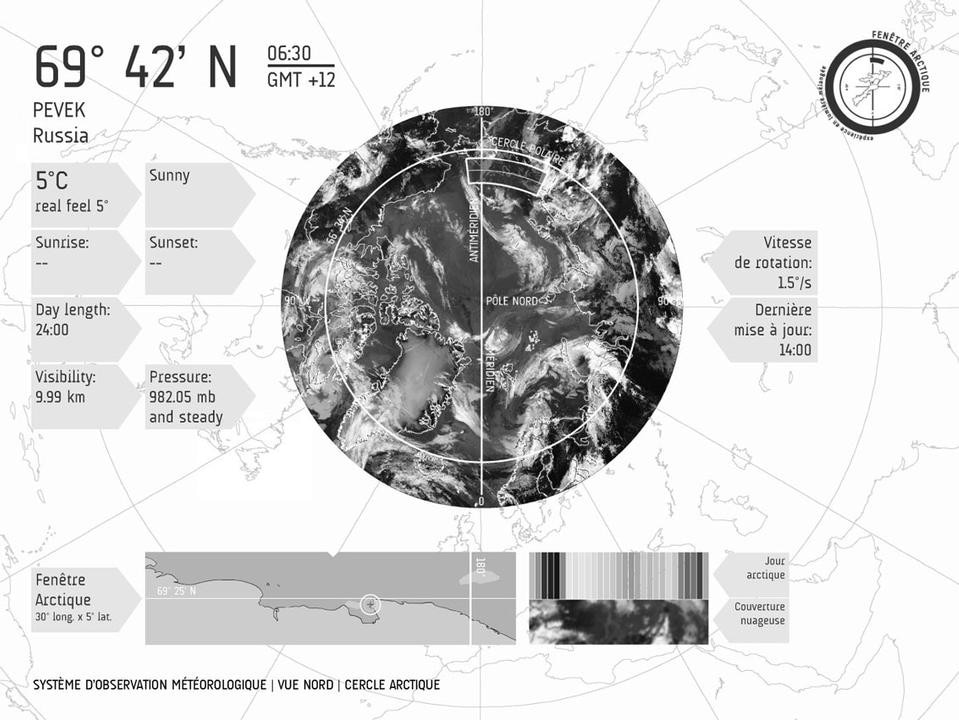
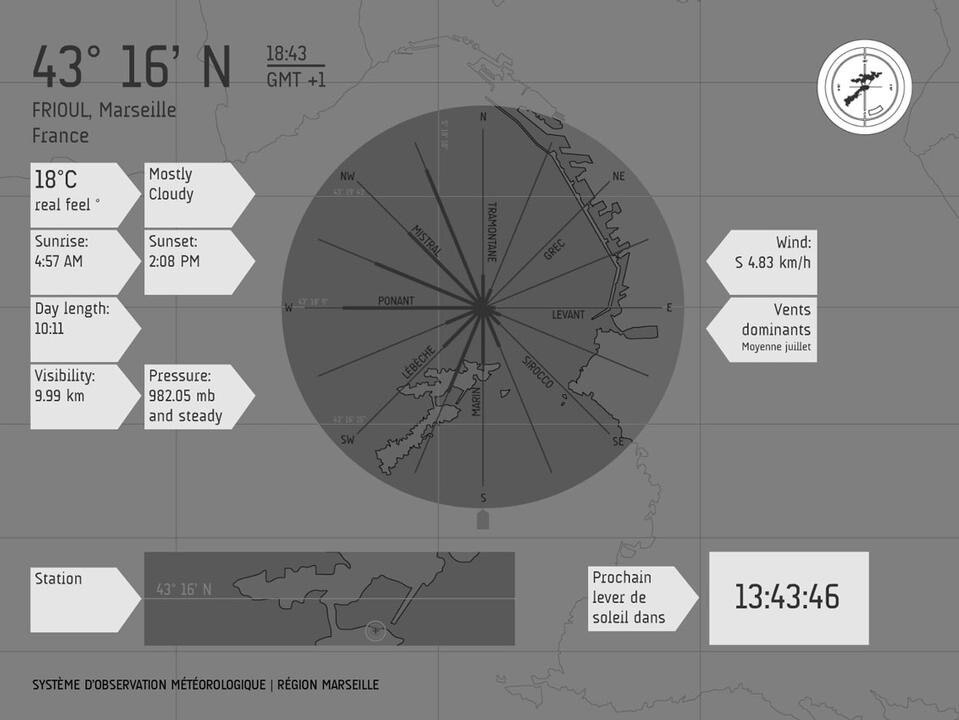
Thursday, July 15. 2010
Via fabric | ch
-----


---
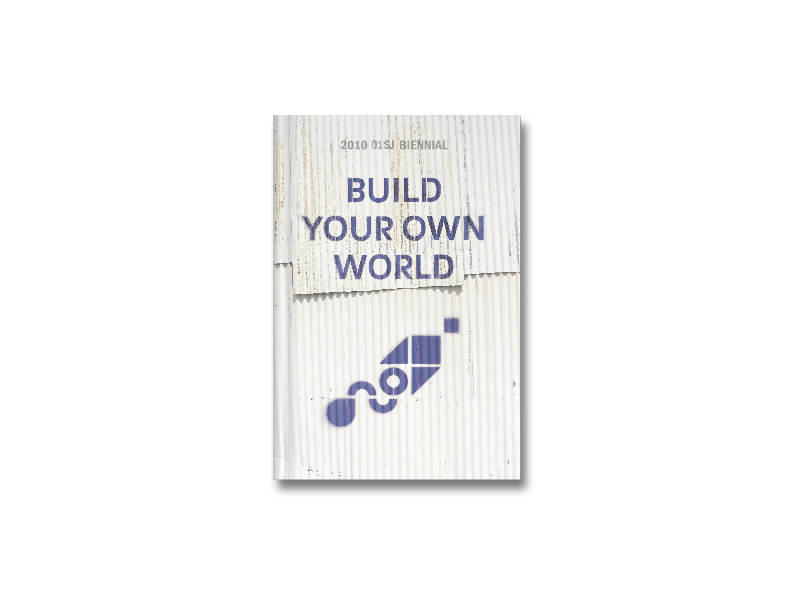
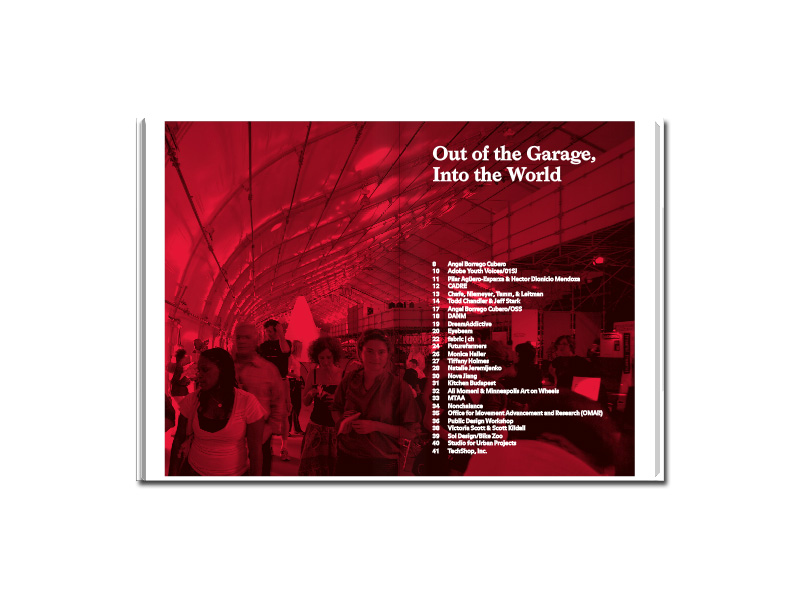
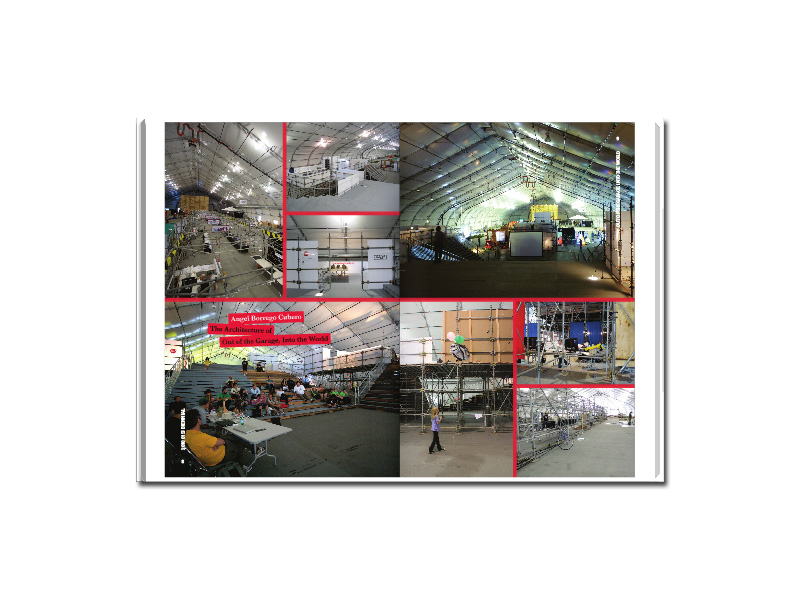
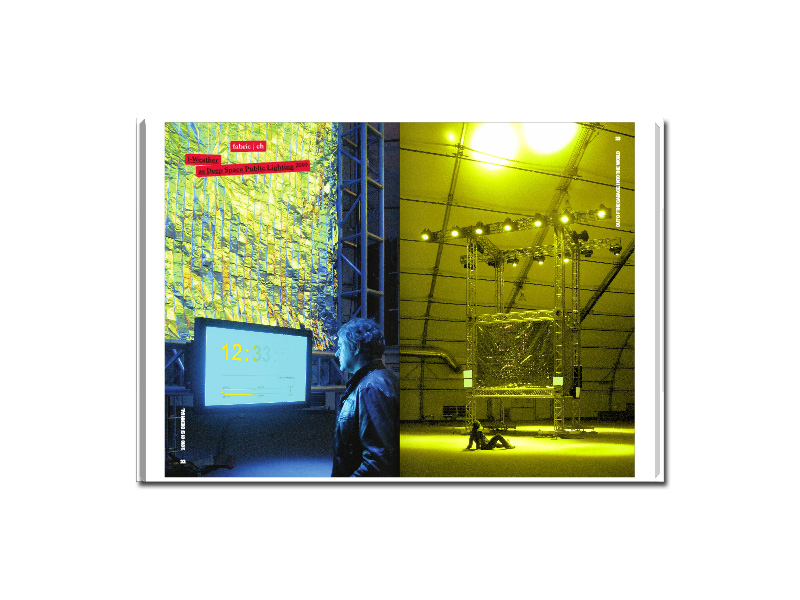
Wednesday, July 07. 2010
Via Pruned
-----
by Alexander Trevi

(How's your weather?)
When we set out to upgrade our Blogger Classic Template to Blogger Layouts (or is it Blogger Design?), we planned on streamlining the layout into just one column. But then we accidentally stumbled upon an embeddable personal artificial sun. We were instantly smitten, and knew we had to incorporate it into the new design, single column be damned.
Courtesy of Philippe Rahm and fabric | ch, this sun now flickering above is simply the background color mutating through a 25-hour cycle of bright hues, from warm oranges to fresh greens and cool blues, then back again. These retinal oscillations are an attempt at creating an artificial climate, one which satisfies “the metabolic and physiological requirements of a human being in an environment partially or completely removed from earthly influences: mediated reality, networks and netlag, the disruption of the body clock that comes with air travel, as well as with extra-terrestrial trips and holidays.”
Accessible everywhere and to everybody thanks to the Internet, this artificial climate called i-weather makes it possible to live in a situation completely removed from natural locations by producing an artificial circadian rhythm synchronised to match the inner cycle of the human hormonal and endocrine system. In the absence of the natural terrestrial cycle of day and night, it becomes apparent that this inner cycle in fact lasts around 25 hours, and that body temperature, the alternation between sleep and wakefulness, and the accumulation and secretion of substances such as cortisone and oligopeptides, all depend on it.
Stare for awhile at our twinkling blog or somebody else's and any temporal and spatial displacement you might have acquired from marathon coding or CADing sessions will hopefully be mitigated.
Of course, you could also hack a TV to blast your room with a pastel maelstrom. At airports all over the world, there could also be coin-operated Artificial Weather Climate Rooms for One in which the eternally jet lagged stabilize themselves with a refreshing technicolor shower. Should such enclosures be considered a security threat, perhaps an iPhone reconfigured as a portable weather machine might be enough to spatially and temporally normalize yourself.
In the Archives:
Tropicalia
Personal comment:
We very recently released a new version of I-Weather, a speculative proposition for an artificial climate based on light therapy principles, mainly. It will be used for an installation later this year in San Francisco - San Jose (the 01SJ biennal of curator Steve Dietz).
The climate is open source and free to use. More free applications and pieces of code should appear along the way.
But as I noticed today that Alexander Trevi from Pruned decided to use it on its blog, I take the opportunity to pinpoint it!
Friday, September 18. 2009
Via Lift Conference channel
-----
Founding member Patrick Keller speaks for fabric | ch during Lift 2009 in Jeju, South Korea. Subject of the talk: Inhabiting spatial interferences.
Thursday, September 10. 2009
Via Edible Geography & BLDGBLOG
-----
By Nicola
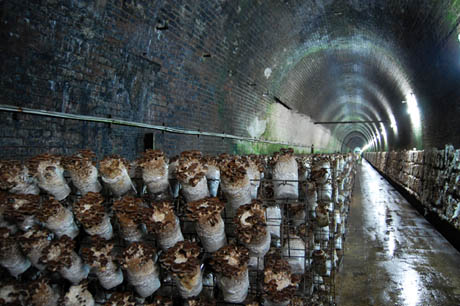
Shiitake logs on racks in the Mittagong mushroom tunnel. All photos in this post taken by the author.
As Geoff Manaugh has already mentioned on BLDGBLOG , we spent our last full day in Australia touring the Li-Sun Exotic Mushroom Farm with its founder and owner, Dr. Noel Arrold. Three weeks earlier at a Sydney farmers’ market, we were buying handfuls of his delicious Shimeji and Chestnut mushrooms to make a risotto, when the vendor told us that they had been grown in a disused railway tunnel in Mittagong. , we spent our last full day in Australia touring the Li-Sun Exotic Mushroom Farm with its founder and owner, Dr. Noel Arrold. Three weeks earlier at a Sydney farmers’ market, we were buying handfuls of his delicious Shimeji and Chestnut mushrooms to make a risotto, when the vendor told us that they had been grown in a disused railway tunnel in Mittagong.
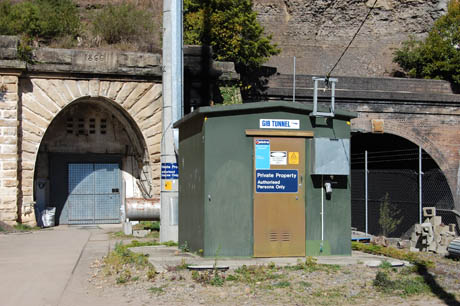
The mushroom tunnel, on the left, was originally built in 1886 to house a single-track railway line. By 1919, it had to be replaced with the still-functioning double-track tunnel to its right, built to cope with the rise in traffic on the route following the founding of Canberra, Australia’s purpose-built capital city. The tunnel is still state property: the mushroom farm exists on a five-year lease.
The idea of re-purposing abandoned civic infrastructure as a site for myco-agriculture was intriguing, to say the least, so we were thrilled when Dr. Arrold kindly agreed to take the time to give us a tour (Li-Sun is not usually open to the public).
Dr. Arrold has been growing mushrooms in the Mittagong tunnel for more than twenty years, starting with ordinary soil-based white button mushrooms and Cremini, before switching to focus on higher maintenance (and more profitable) exotics such as Shimeji, Wood-ear, Shiitake, and Oyster mushrooms.
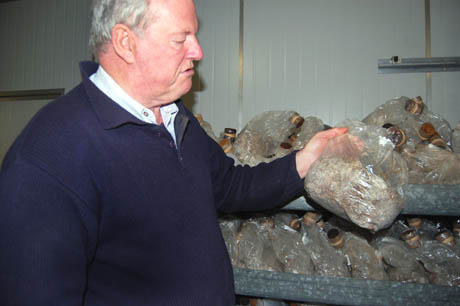
Dr. Arrold with a bag of mushroom spawn. He keeps his mushroom cultures in test-tubes filled with boiled potato and agar, and initially incubates the spawn on rye or wheat grains in clear plastic bags sealed with sponge anti-mould filters (shown above), before transferring it to jars, black bin bags, or plastic-wrapped logs.
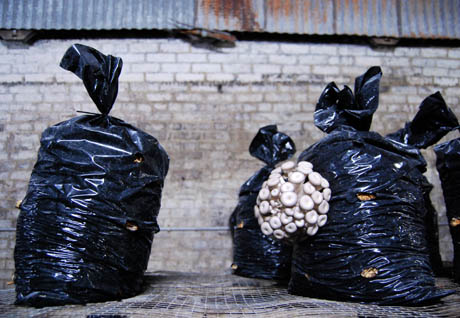
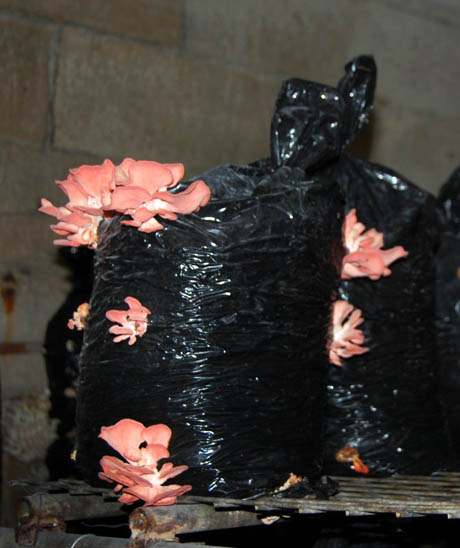
Shimeji (above) and pink oyster (below) mushrooms cropping on racks inside the tunnel. Dr. Arrold came up with the simple but clever idea of growing mushrooms in black bin bags with holes cut in them. Previously, mushrooms were typically grown inside clear plastic bags. The equal exposure to light meant that the mushrooms fruited all over, which made it harder to harvest without missing some.
A microbiologist by training, Dr. Arrold originally imported his exotic mushroom cultures into Australia from their traditional homes in China, Japan, and Korea. Like a latter-day Tradescant, he regularly travels abroad to keep up with mushroom growing techniques, share his own innovations (such as the black plastic grow-bags shown above), and collect new strains.
He showed us a recent acquisition, which he hunted down after coming across it in his dinner in a café in Fuzhou, and which he is currently trialling as a potential candidate for cultivation in the tunnel. Even though all his mushroom strains were originally imported from overseas (disappointingly, given its ecological uniqueness, Australia has no exciting mushroom types of its own), Dr. Arrold has refined each variety over generations to suit the conditions in this particular tunnel.
Since there is currently only one other disused railway tunnel used for mushroom growing in the whole of Australia, his mushrooms have evolved to fit an extremely specialised environmental niche: they are species designed for architecture.
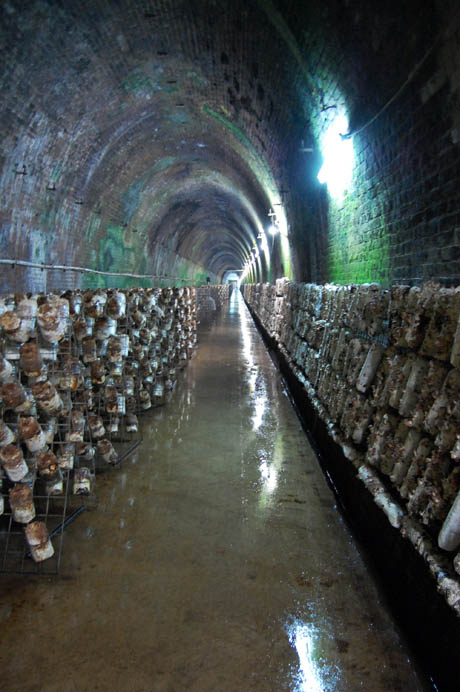
Shiitake logs on racks (Taiwanese style) and mounted on the wall (Chinese style) in the tunnel.
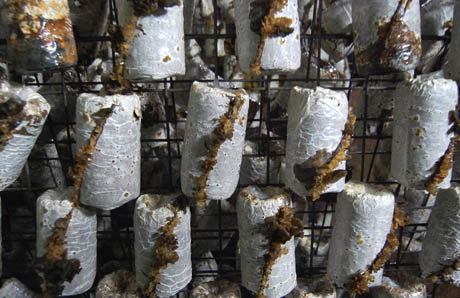
Wood-ear mushrooms grow through a diagonal slash in plastic bags filled with chopped wheat straw.
The tunnel for which these mushrooms have been so carefully developed is 650 metres long and about 30 metres deep. Buried under solid rock and deprived of the New South Wales sunshine, the temperature holds at a steady 15º Celsius. The fluorescent lights flick on at 5:30 a.m. every day, switching off again exactly 12 hours later. The humidity level fluctuates seasonally, and would reach an unacceptable aridity in the winter if Dr. Arrold didn’t wet the floors and run a fogger during the coldest months.
In all other respects, the tunnel is an unnaturally accurate concrete and brick approximation of the prevailing conditions in the mushroom-friendly deep valleys and foggy forests of Fujian province. This inadvertent industrial replicant ecosystem made me think of Swiss architecture firm Fabric’s 2008 proposal for a “Tower of Atmospheric Relations” (pdf).
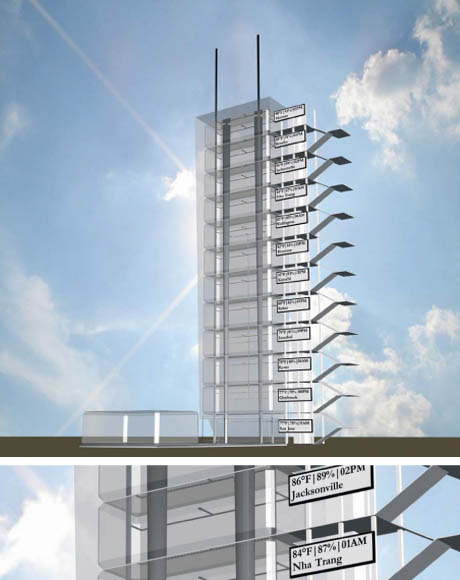
Renderings of Fabric’s “Tower of Atmospheric Relations,” showing the stacked volumes of air and the resulting climate simulations.
Fabric’s ingenious project is designed to generate a varying set of artificial climates (such as the muggy heat of the Indian monsoon, or the crisp air of a New England autumn day) entirely through the movements of the air that is trapped inside the tower’s architecture (i.e. by means of convection, condensation, thermal inertia, and so on).
If you could perhaps combine this kind of atmosphere-modifying architecture with today’s omnipresent vertical farm proposals, northern city dwellers could simultaneously avoid food miles and continue to enjoy bananas.
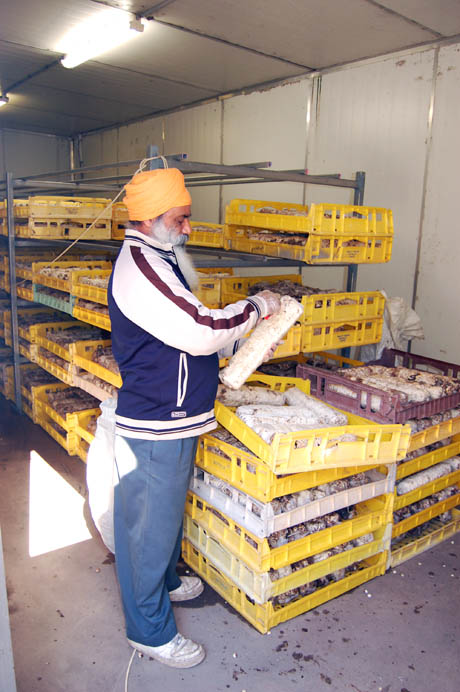
Li-Sun employees unwrapping mushroom logs before putting them on racks in the tunnel. The logs are made by mixing steamed bran or wheat, sawdust from thirty-year-old eucalyptus, and lime in a concrete mixer, packing it into plastic cylinders, and inoculating them with spawn.
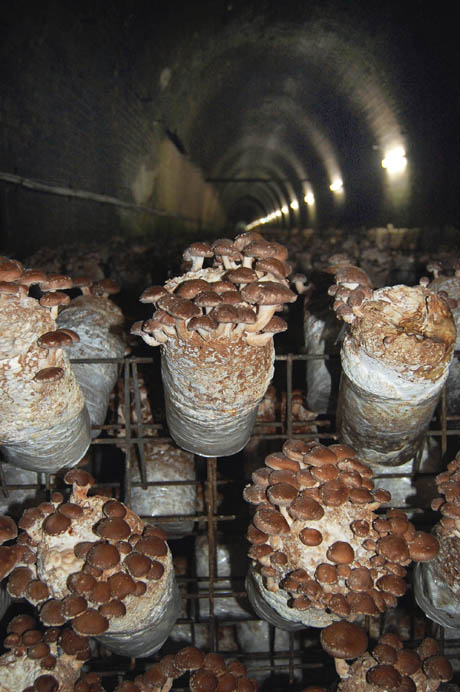
Fruiting Shiitake logs on racks in the tunnel. Once their mushrooms are harvested, the logs make great firewood.
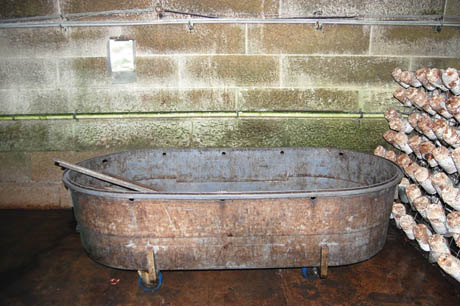
The Shiitake log shock tank – Dr. Arrold explained that the logs crop after one week in the tunnel, and then sit dormant for three weeks, until they are “woken up” with a quick soak in a tub of water, after which they are productive for three or four more weeks. “Shiitake,” said Dr. Arrold, in a resigned tone, “are the most trouble, and the biggest market.”
Outside of the tunnel, Dr. Arrold also grows Enoki, King Brown, and Chestnut mushrooms. These varieties prefer different temperatures (6º, 17º, and 18º Celsius respectively), so they are housed in climate-controlled Portakabins.
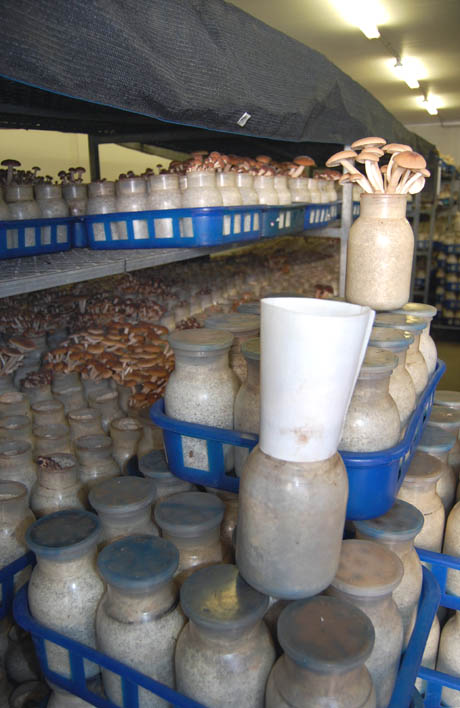
The paper cone around the top of the enoki jar helps the mushrooms grow tall and thin.
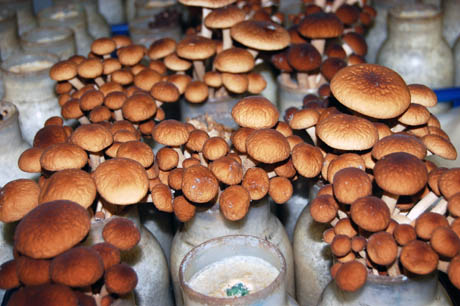
Chestnut mushrooms grow in jars for seven weeks: four to fruit, and three more to sprout to harvest size above the jar’s rim.
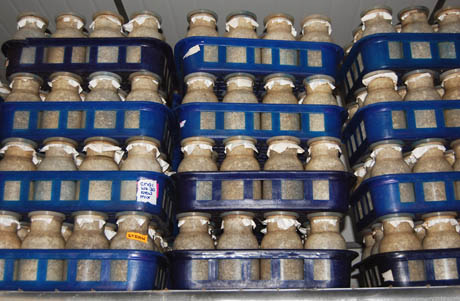
Thousands of mushroom jars are stacked from floor to ceiling. Dr. Arrold starting growing these mushroom varieties in jars two years ago, and hasn’t had a holiday since.
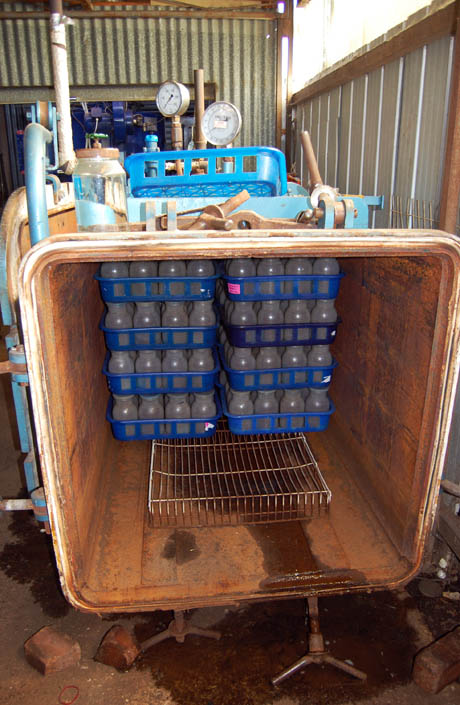
Empty mushroom jars are sterilised in the autoclave between crops, so that disease doesn’t build up.
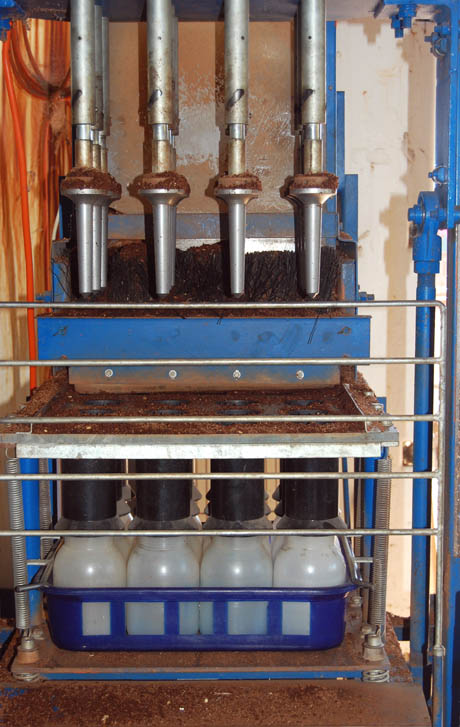
The clean jars are filled with sterilised substrate using a Japanese-designed machine, before being inoculated with spawn.
The fact that the King Brown and Chestnut mushrooms only thrive at a higher temperature than the railway tunnel provides makes their cultivation much more expensive. Their ecosystem has to be replicated mechanically, rather than occuring spontaneously within disused infrastructure.
I couldn’t help but wonder whether there might be another tunnel, cave, or even abandoned bunker in New South Wales that currently maintains a steady 17º Celsius and is just waiting to be colonised by King Brown mushrooms growing, like ghostly thumbs, out of thousands of glass jars.
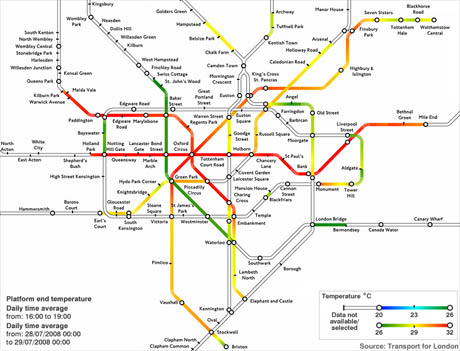
Temperature map of the London Underground system (via the BBC, where a larger version is also available), compiled by Transport for London’s “Cool the Tube” team.
In the UK, for instance, Transport for London has kindly provided this fascinating map of summertime temperatures on various tube lines. Most are far too hot for mushroom growing (not to mention commuter comfort). Nonetheless, perhaps the estimated £1.56 billion cost of installing air-conditioning on the surface lines could be partially recouped by putting some of the system’s many abandoned service tunnels and shafts to use cultivating exotic fungi. These mushroom farms would be buried deep under the surface of the city, colonizing abandoned infrastructural hollows and attracting foodies and tourists alike.

A very amateur bit of Photoshop work: Li-Sun Mushrooms as packaged for Australian supermarket chain Woolworths, re-imagined as Bakerloo Line Oyster Mushrooms.
Service shafts along the hot Central line might be perfect for growing Chestnut Mushrooms, while the marginally cooler Bakerloo line has several abandoned tunnels that could replicate the subtropical forest habitat of the Oyster Mushroom. And – unlike Dr. Arrold’s Li-Sun mushrooms, which make no mention of their railway tunnel origins on the packaging – I would hope that Transport for London would cater to the locavore trend by labeling its varietals by their line of origin.
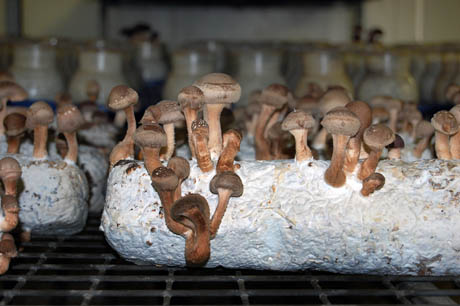
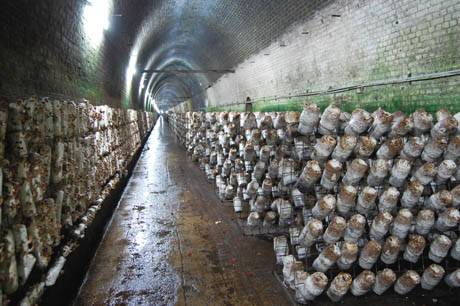
Shiitake logs on racks in the Mittagong mushroom tunnel.
Speculation aside, our visit to the Mittagong Mushroom Tunnel was fascinating, and Dr. Arrold’s patience in answering our endless questions was much appreciated. If you’re in Australia, it’s well worth seeking out Li-Sun mushrooms: you can find them at several Sydney markets, as well as branches of Woolworths.
[NOTE: This post was simultaneously published at Edible Geography's sister-site BLDGBLOG.]
Personal comment:
Surprenante culture de champignons en climats déplacés. Carte climatique du métro londonien y suggérant également l'idée de climats déplacés (!) et intéressante idée de Nicola Twiley (éditrice du blog Edible Gography) d'utiliser notre Tower of Atmospheric Relations pour du "vertical urban farming".
|








